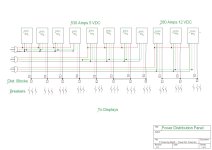This was my first year of doing a show. I didn't do too much just the eve line, outline windows, not so mega tree, five arches, and a tune to pixel panel. I used separate power supplies and boxes for all of these. I am starting to plan next year's projects. I think instead of having many separate power boxes all located in the same area it will be better to make a large Power Distribution Panel. I have made a drawing of how I think it will need to be wired. I would appreciate for anyone to look at the drawing and make sure it is correct. Yes, its BIG but I am trying to make one and be done. I plan on adding some power-hungry items in the future (3- 4' X 8' panels with 1" spacing etc.).
Thanks for your help.
Thanks for your help.

